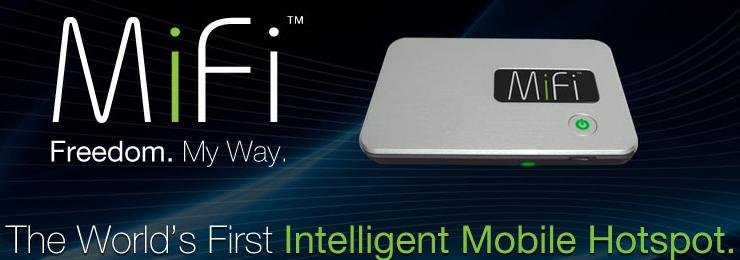BigNick
Siamo solo noi
- Registrato
- 10/7/01
- Messaggi
- 12.305
- Punti reazioni
- 1.289
http://investor.novatelwireless.com/releasedetail.cfm?ReleaseID=388438
Novatel Wireless MiFi 2352 Intelligent Mobile Hotspot Wins 2009 Plus X Award for Innovation and Ease of Use
Industry First Intelligent Mobile Hotspot Honored in Two Categories
SAN DIEGO, Jun 08, 2009 (BUSINESS WIRE) -- Novatel Wireless Inc., (Nasdaq: NVTL) a leading provider of wireless broadband solutions, today announced the Plus X Group has recognized its MiFi 2352 Intelligent Mobile Hotspot as the 2009 winner of the Plus X Awards in the categories of Innovation and Ease of Use.
The industry's first Intelligent Mobile Hotspot for HSPA networks, the MiFi 2352, is a mobile broadband device that creates a personal cloud of high-speed Internet connectivity that can be easily shared between multiple users and Wi-Fi devices such as notebooks, cameras, gaming devices and multimedia players. MiFi enables users to access high-speed Internet from anywhere there is a cellular connection, including moving vehicles where multiple passengers may need Internet access.
Among the key attributes of the MiFi 2352 and recognized as being particularly innovative by the Plus X awards committee, is an on-board Linux based operating system capable of hosting software applications. This ability to host software on the device itself provides cellular operators with a unique platform to deliver bundled software and services for enterprises and consumers such as location based applications and auto-VPN access.
The Plus X Award is presented annually for outstanding technology products in a variety of categories. The Plus X Seal of Approval lends prestige to brand name products in the consumer electronics, mobile entertainment, telecommunications, IT, electronics and photo technology industries. A renowned jury of 144 members from 38 countries selects products that deliver outstanding innovation, design, ease of use, ecology and ergonomics.
"It's a great honor to be recognized in this year's Plus X Awards for the innovation of the MiFi 2352 Intelligent Mobile Hotspot," said Rob Hadley, chief marketing officer for Novatel Wireless. "MiFi 2352 is the result of an unprecedented effort to deliver an industry first, market-leading solution for mobile connectivity. We are very pleased with the overwhelmingly positive response it has received from the European community."
ABOUT THE PLUS X AWARDS
With 144 top-class jury members, neutral in terms of industry preference, from 32 nations, 38 professional partners and a marketing volume of more than four million euros, the Plus X Award is the largest technology, sports and lifestyle competition in the world. Products that can be submitted for the Plus X Award for technology are among others any such in the field of home appliances, IT products, car media, power tools as well as mobile and photo technology. Products that can be submitted for the Plus X Award for sports and lifestyle are such in the field of sportswear, sports equipment, gym equipment and accessories. The contest was initiated by the marketing agency media society networks as a project aimed at strengthening brand names and in 2009 celebrates its sixth year. Plus X Awards are presented for special achievements in the categories Innovation, High Quality, Design, Ease of Use/Functionality, Ergonomics and Ecology.
ABOUT NOVATEL WIRELESS
Novatel Wireless, Inc. is a leader in the design and development of innovative wireless broadband access solutions based on 3G and 4G WCDMA (HSPA & UMTS), CDMA and GSM technologies. Novatel Wireless' USB modems, embedded modules, Intelligent Mobile Hotspot products and software enable high-speed wireless Internet access on leading wireless data networks. The Company delivers specialized wireless solutions to carriers, distributors, OEMs and vertical markets worldwide. Headquartered in San Diego, California, Novatel Wireless is listed on NASDAQ: NVTL. For more information please visit www.novatelwireless.com. (NVTLG)
This release may contain forward-looking statements, which are made pursuant to the safe harbor provisions of the United States Private Securities Litigation Reform Act of 1995, as amended to date. These forward-looking statements involve risks and uncertainties. A number of important factors could cause actual results to differ materially from those in the forward-looking statements contained herein. These factors include risks relating to technological changes, new product introductions, continued acceptance of Novatel Wireless' products and dependence on intellectual property rights. These factors, as well as other factors that could cause actual results to differ materially, are discussed in more detail in Novatel Wireless' filings with the United States Securities and Exchange Commission (available at www.sec.gov) and other regulatory agencies.
(C) 2009 Novatel Wireless. All rights reserved. The Novatel Wireless name, logo, MiFi and Intelligent Mobile Hotspot are trademarks of Novatel Wireless, Inc. Other product or service names mentioned herein are the trademarks of their respective owners.
Novatel Wireless MiFi 2352 Intelligent Mobile Hotspot Wins 2009 Plus X Award for Innovation and Ease of Use
Industry First Intelligent Mobile Hotspot Honored in Two Categories
SAN DIEGO, Jun 08, 2009 (BUSINESS WIRE) -- Novatel Wireless Inc., (Nasdaq: NVTL) a leading provider of wireless broadband solutions, today announced the Plus X Group has recognized its MiFi 2352 Intelligent Mobile Hotspot as the 2009 winner of the Plus X Awards in the categories of Innovation and Ease of Use.
The industry's first Intelligent Mobile Hotspot for HSPA networks, the MiFi 2352, is a mobile broadband device that creates a personal cloud of high-speed Internet connectivity that can be easily shared between multiple users and Wi-Fi devices such as notebooks, cameras, gaming devices and multimedia players. MiFi enables users to access high-speed Internet from anywhere there is a cellular connection, including moving vehicles where multiple passengers may need Internet access.
Among the key attributes of the MiFi 2352 and recognized as being particularly innovative by the Plus X awards committee, is an on-board Linux based operating system capable of hosting software applications. This ability to host software on the device itself provides cellular operators with a unique platform to deliver bundled software and services for enterprises and consumers such as location based applications and auto-VPN access.
The Plus X Award is presented annually for outstanding technology products in a variety of categories. The Plus X Seal of Approval lends prestige to brand name products in the consumer electronics, mobile entertainment, telecommunications, IT, electronics and photo technology industries. A renowned jury of 144 members from 38 countries selects products that deliver outstanding innovation, design, ease of use, ecology and ergonomics.
"It's a great honor to be recognized in this year's Plus X Awards for the innovation of the MiFi 2352 Intelligent Mobile Hotspot," said Rob Hadley, chief marketing officer for Novatel Wireless. "MiFi 2352 is the result of an unprecedented effort to deliver an industry first, market-leading solution for mobile connectivity. We are very pleased with the overwhelmingly positive response it has received from the European community."
ABOUT THE PLUS X AWARDS
With 144 top-class jury members, neutral in terms of industry preference, from 32 nations, 38 professional partners and a marketing volume of more than four million euros, the Plus X Award is the largest technology, sports and lifestyle competition in the world. Products that can be submitted for the Plus X Award for technology are among others any such in the field of home appliances, IT products, car media, power tools as well as mobile and photo technology. Products that can be submitted for the Plus X Award for sports and lifestyle are such in the field of sportswear, sports equipment, gym equipment and accessories. The contest was initiated by the marketing agency media society networks as a project aimed at strengthening brand names and in 2009 celebrates its sixth year. Plus X Awards are presented for special achievements in the categories Innovation, High Quality, Design, Ease of Use/Functionality, Ergonomics and Ecology.
ABOUT NOVATEL WIRELESS
Novatel Wireless, Inc. is a leader in the design and development of innovative wireless broadband access solutions based on 3G and 4G WCDMA (HSPA & UMTS), CDMA and GSM technologies. Novatel Wireless' USB modems, embedded modules, Intelligent Mobile Hotspot products and software enable high-speed wireless Internet access on leading wireless data networks. The Company delivers specialized wireless solutions to carriers, distributors, OEMs and vertical markets worldwide. Headquartered in San Diego, California, Novatel Wireless is listed on NASDAQ: NVTL. For more information please visit www.novatelwireless.com. (NVTLG)
This release may contain forward-looking statements, which are made pursuant to the safe harbor provisions of the United States Private Securities Litigation Reform Act of 1995, as amended to date. These forward-looking statements involve risks and uncertainties. A number of important factors could cause actual results to differ materially from those in the forward-looking statements contained herein. These factors include risks relating to technological changes, new product introductions, continued acceptance of Novatel Wireless' products and dependence on intellectual property rights. These factors, as well as other factors that could cause actual results to differ materially, are discussed in more detail in Novatel Wireless' filings with the United States Securities and Exchange Commission (available at www.sec.gov) and other regulatory agencies.
(C) 2009 Novatel Wireless. All rights reserved. The Novatel Wireless name, logo, MiFi and Intelligent Mobile Hotspot are trademarks of Novatel Wireless, Inc. Other product or service names mentioned herein are the trademarks of their respective owners.




